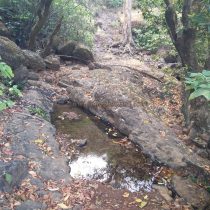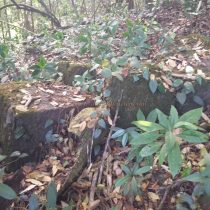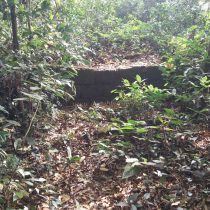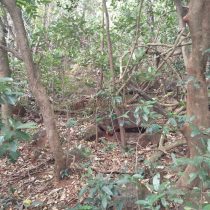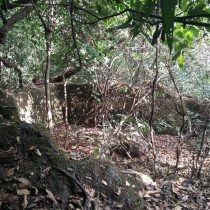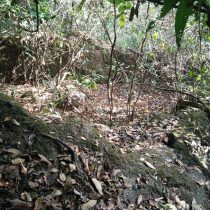MUDAGAD
TYPE : HILL FORT
DISTRICT : KOLHAPUR
HEIGHT : 2655 FEET
GRADE : MEDIUM
In Kolhapur district trekking Mudagad was my last fort. My exploration of 12 out of 13 forts in Kolhapur district was completed but I could not visit Mudagad. Often something was going wrong with the plan. The main reason for this is an important suggestion not to go to the fort without being with a guide. When I visited Mudagad, I realized how important this suggestion was. Mudagad is a fort lost in the dense forest. The people of the area do not even know that there is a fort called Mudagad except for the people in Padsali village. This fort, situated on the top of Sahyadri, west of Panhala taluka is the guardian of Kazirda Ghat. The fort is surrounded by dense forest and Padsali is a village of 20-22 houses at the eastern foothills. At the western direction in the bottom of a deep valley is the Rajpur taluka of Ratnagiri district. Kazirda Ghat was formerly used to travel from Kolhapur to Konkan.
...
Mudagad was built near the wharf to protect the Kazirda ghat. To reach Mudagad, there are two villages, Kode and Padsali. As it is pretty difficult to get a guide from Kode village, most of the trekkers prefer to go from Padsali village. Padsali village is 53 km from Kolhapur. The path to the fort is from Kolhapur-Kale-Bazarbhogave-Kisrul-Kaljavade-Padsali. Since the fort is in a dense forest, the footpaths and the markings on the fort are completely covered by leaves. Even if you miss a turn, there is a possibility of getting lost in the forest, so it is essential to have a local guide along with you to the fort. Padsali village is now a camping destination and due to this tourism is developing in this village. To show the fort, the guide demands more money. Even when there is no need, another person comes along with the guide and asks for money after returning, and if don't give them money, they argue. So no matter how sweet the guide speaks, you should decide the money to be given to the guide before going to the fort. Mudagad is seen to the west from Padsali village. A dirt road passes through the village towards Kazirda Ghat. After crossing some distance on this road you have to cross a stream. Due to the release of water from Padsali dam in this stream which meets river Kumbhi, there is water throughout the year. As the water from the waterfall is unreliable, it should be filled from this stream. After crossing the stream a little further, a footpath leaves the road and enters the field on the left, while the straight road leads to Karjirda Ghat. After a short walk from the field, the path turns right and enters the trees and bushes. Here is a mound of stones marking the boundaries of the forest. Once we enter through these trees and bushes, we start climbing the mountain. This climb takes about 15 to 20 minutes to reach the center of the mountain. Looking back from here, we see Padsali village and Padsali dam situated at the foot of the hill. There is a perennial waterfall on the hill. This is the only source of water on the way to the fort. From here, the path to the fort passes through dense forest. The forest is so dense that you can't see any area under the fort above the trees and you can't even understand the directions. In 2-3 places, there is an open ground of one hundred and fifty feet but it is surrounded by forest. In about an hour, we reach the top of the fort by climbing two small hills. We don't feel tired as the sun’s heat is obstructed by the trees in the forest. In many places along the way, arrows pointing to the road are painted, but these marks are blurred and often hidden under leaves. Your entrance to the fort is through the rocky outcrops on the hilltop. It takes 2 hours to reach here from Padsali village. Mudagad is 3190 feet above sea level. The forest has overgrown in the fort and due to this, the fort has been destroyed. All the constructions of the fort have collapsed and huge trees have grown in it. It is very difficult to see the ramparts of the fort through these trees. The head of the fort is very small and no remnants can be seen except the 15 to 20 feet ramparts. Walking through the bushes, one can see 3 bastions and some remaining fortifications connecting them. There is a small space in the middle of the head and there is a small round curved stone. Mudagad is a small quadrangular fort of 400x150 feet in length mainly built for surveillance. At the time of construction of the fort, the forest here must have been from the past and the fort must have been built with its support. The forest at the top is so dense that the surrounding area cannot be seen from any side. Walking around the fort, you can see dry water cisterns carved in the rock. But this is not a cistern, but a pit that fell due to stone taken during the construction of the fort. Apart from this, a long pit can be seen on the footpath leading to Kode village. It is said that Shahu Maharaj dug this trench to prevent the wind animals of the forest from coming down to the village, but it does not seem to be relevant. This is where your fort round ends. Half an hour is enough to walk around the entire fort. Although it is not known exactly who built Mudagad and when but some document mention that Nanasaheb Peshwa has been built Mudagad near Karveerkar's territory between 1742 and 1747. This is mentioned in the Peshwa documents of 1748. After a feud between Nanasaheb Peshwa and Tulaji Angre, Tulaji Angre started attacking the territory of Sawant and Karveerkar. In a letter from the Peshwa Daftar, Ramchandra Bawaji writes to the Peshwa about the siege and battle of Mudagad. he says the place which was established by you earlier Tulaji Angre built a fort and settled in it. From there, all the Panhalas conquered the province. Sawantwadikar, Bawdewale (Karveerkar), and Yesaji Angre all came together and took Mudagad with four-five hundred cavalries and seven-eight thousand infantry and burnt all the villages from Rajapura to Sangameshwar. Bhagwantrao and Sawant had laid siege to Mudagad. Two to four hundred rounds of ammunition and weapons were found on the fort. The people at Muda are also trying to fight. Yesaji Angre and Sawantwadikar together besieged Mudagad and conquered the fort. Later, in a letter dated 1839, it is recorded that for the security of Mudagad, 10 people of Jotyajirao Chavan were kept in Kajirda Ghat security. Shahu Maharaj of Karveer had declared this area as Shivaranya and released elephants here. If you want to stay in Padsali village, you can stay in school. This school can accommodate 10-12 people.
© Suresh Nimbalkar

